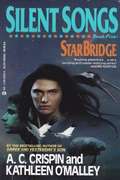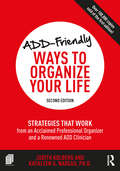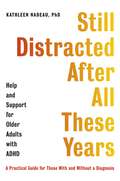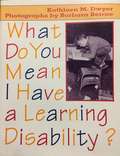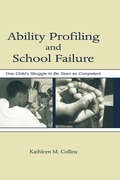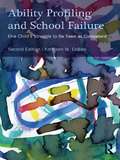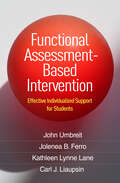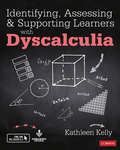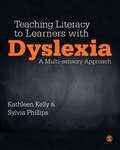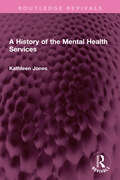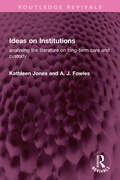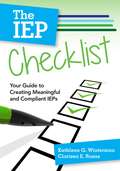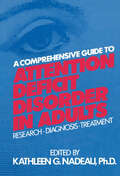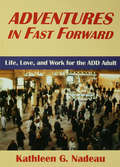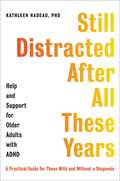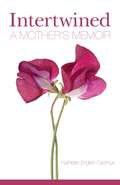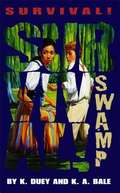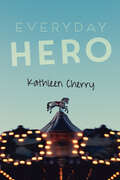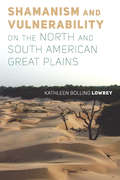- Table View
- List View
Silent Songs (Starbridge #5)
by A. C. Crispin Kathleen O'MalleyThe men and women of StarBridge found intelligent life -- and new friends -- across the galaxy... In the skies of Trinity, the birdlike Grus welcomed the deaf human ambassador, Tesa. In the seas of Trinity, the aquatic Singers communicated with the young telepath, Jib. But on the surface of Trinity, a different kind of life form has landed. They are amphibious beings from a distant world. And they are definitely -not- friendly...
ADD-Friendly Ways to Organize Your Life: Strategies that Work from an Acclaimed Professional Organizer and a Renowned ADD Clinician
by Kathleen Nadeau Judith KolbergAcclaimed professional organizer Judith Kolberg and Dr. Kathleen Nadeau, renowned ADHD clinical psychologist, are back with an updated edition of their classic text for adults with ADD. Their collaboration offers the best understanding and solutions for adults who want to get and stay organized. Readers will enjoy all new content on organizing digital information, managing distractions, organizing finances, and coping with the "black hole" of the Internet. This exciting new resource offers three levels of strategies and support: self-help, non-professional assistance from family and friends, and professional support; allowing the reader to determine the appropriate level of support.
Still Distracted After All These Years: Help and Support for Older Adults with ADHD
by Kathleen NadeauThe world's foremost expert shares advice on later-in-life ADHD, tackling everything from finances, parenting, planning for retirement, social life and work, in this practical and helpful guide for those with and without a diagnosis.Do you...· Forget to pay bills?· Live in a disorganised environment?· Struggle with mental health?· Procrastinate on projects, even ones that initially excite you?· Have high levels of conflict with those close to you?· Have a child diagnosed with ADHD and/or a family history of learning disorders?If some of these patterns sound familiar, you might understandably fear the onset of dementia, but you may have undiagnosed attention deficit hyperactivity disorder (ADHD). ADHD in adults is one of the most common disorders. Living with ADHD in our later years is hugely influenced by co-occurring issues, such as anxiety, depression or low self-esteem. In addition, the presence of learning disorders, heightened levels of stress, the presence or lack of support from others, and the number of people we are responsible for, can all complicate and intensify the effects of ADHD.The good news is that you've come to the right place to learn more about how to lead a calmer, happier, more productive life. Dedicated to the health and wellbeing of today's older adults with ADHD, Still Distracted After All These Years offers strategies to build a support system, gain better control over your daily life and create a more ADHD-friendly retirement.
Program Planning and Evaluation for Blind and Visually Impaired Students: National Guidelines for Educational Excellence
by Kathleen Mary Huebner Jack HazekampThe guidelines have been developed as a resource for parents, staff, and administrators in identifying and assessing the unique needs of visually impaired students and planning, providing, evaluating, and improving the quality and cost-effectiveness of programs serving these students.
The National Agenda for the Education of Children and Youths with Visual Impairments, Including Those with Multiple Disabilities
by Kathleen M. Huebner Brunhilde Merk-Adam Donna Stryker Karen WolffeWhat the National Agenda Means for Visually Impaired Children, Development of the National Agenda, National Agenda Goal Statements, Importance of the Goal Statements, Strategies for Achieving the Goal Statements, Achievement of the Goal Statements, National Agenda Steering Committee, National Goals and Leader Organizations, Endorsements.
What Do You Mean I Have a Learning Disability?
by Kathleen M. DwyerTen-year-old Jimmy just accepts the fact that other kids can do things better than he can. It's always been that way--but now Jimmy is starting to think there must be a reason. One day he whispers to his cat, "I'm so stupid. I know I am." This true story has a happy ending. One of Jimmy's teachers encouraged his parents to have Jimmy tested, and it turned out that he had a learning disability. Hard work and perseverance, and the support of his family, helped Jimmy overcome his disability. For children who are learning disabled, and for their families and friends, this inspiring book offers encouragement and support in a shared effort.
Ability Profiling and School Failure: One Child's Struggle to Be Seen As Competent
by Kathleen M. Collins Kathleen M CollinsAbility Profiling and School Failure: One Child's Struggle to Be Seen as Competent explores the social and contextual forces that shape the appearance of academic ability and disability and how these forces influence the perception of academic underachievement of minority students. It is a powerful case study of a competent fifth grader, an African American boy growing up in a predominantly white, rural community, who was excluded from participating in science and literacy discourses within his classroom community. The case study form allows for the integration of the story of the student's struggle to be seen as competent in school, a context where his teacher perceives him as learning disabled, with Collins' own perspective as a researcher and teacher-educator engaged in a professional development effort with the teacher. The contribution of this book is to make visible the situated and socially constructed nature of ability, identity, and achievement, and to illustrate the role of educational and social exclusion in positioning students within particular identities. Highly relevant across the field of education, this book will particularly interest researchers, graduate students, and professionals in literacy and science education, curriculum and instruction, sociocultural theories of learning, discourse analysis of classrooms, research on teaching and learning, special education, social foundations, and teacher education.
Ability Profiling and School Failure: One Child's Struggle to be Seen as Competent
by Kathleen M. CollinsAbility Profiling and School Failure, Second Edition explores the social and contextual forces that shape the appearance of academic ability and disability and how these forces influence the perception of academic underachievement of minority students. At the book’s core is the powerful case study of a competent fifth grader named Jay, an African American boy growing up in a predominantly white, rural community, who was excluded from participating in science and literacy discourses within his classroom community. In this new edition, researcher and teacher-educator Kathleen Collins situates the story of Jay’s struggle to be seen as competent within current scholarly conversations about the contextualized nature of dis/ability. In particular, she connects her work to recent research into the overrepresentation of minority students in special education, exploring the roles of situated literacies, classroom interactions, and social stereotypes in determining how some students come to be identified as "disabled." Ability Profiling and School Failure, Second Edition comprises a thorough investigation into the socially constructed nature of ability, identity, and achievement, illustrating the role of educational and social exclusion in positioning students within particular identities.
Functional Assessment-Based Intervention: Effective Individualized Support for Students
by Kathleen Lynne Lane John Umbreit Jolenea B. Ferro Carl J. LiaupsinFrom noted authorities, this book presents a comprehensive approach to designing and implementing evidence-based Tier 3 behavior interventions for K–12 students. The authors' functional assessment-based intervention (FABI) process has been supported by multiple peer-reviewed studies conducted in authentic educational environments. Step by step, chapters spell out proven methods to define target behaviors, determine the function of the undesirable behavior, identify appropriate replacement behaviors, and deliver and monitor intensive interventions. Illustrated with real-world case examples, the book shows how to embed FABI within a school's integrated tiered system of supports. Guidance for scaling FABI district- and statewide is also provided. Ethical issues, professional standards, equity concerns, and cultural and linguistic considerations are addressed throughout. In a convenient large-size format, the book includes reproducible checklists and forms that can also be downloaded for ease of use.
Identifying, Assessing and Supporting Learners with Dyscalculia (Corwin Ltd)
by Kathleen Kelly***** Online Resources are open access. No code is required ***** It is vital to understand the challenges and provide the right support for learners with dyscalculia and specific learning difficulties in mathematics. The book provides: • an overview of current research explaining the nature and causation of dyscalculia • guidance on the identification of dyscalculia • examples of how to carry out informal and formal assessments • an explanation of the principles of multisensory mathematics teaching • an outline of a structured programme (for learners aged 5-14), together with examples of lesson planning and activities. Designed for teachers specialising in the assessment and teaching of learners with dyscalculia, and those undertaking courses leading to Approved Teacher Dyscalculia (ATD) and Associate Membership of the British Dyslexia Association (AMBDA), the book is useful to any professional looking for an understanding of this area of specific difficulty.
Identifying, Assessing and Supporting Learners with Dyscalculia (Corwin Ltd)
by Kathleen Kelly***** Online Resources are open access. No code is required ***** It is vital to understand the challenges and provide the right support for learners with dyscalculia and specific learning difficulties in mathematics. The book provides: • an overview of current research explaining the nature and causation of dyscalculia • guidance on the identification of dyscalculia • examples of how to carry out informal and formal assessments • an explanation of the principles of multisensory mathematics teaching • an outline of a structured programme (for learners aged 5-14), together with examples of lesson planning and activities. Designed for teachers specialising in the assessment and teaching of learners with dyscalculia, and those undertaking courses leading to Approved Teacher Dyscalculia (ATD) and Associate Membership of the British Dyslexia Association (AMBDA), the book is useful to any professional looking for an understanding of this area of specific difficulty.
Teaching Literacy to Learners with A Multi-sensory Approach Dyslexia
by Kathleen KellyProviding a structured programme for teaching literacy to children and young people with dyslexia and specific literacy difficulties, this book makes explicit links between theory, research and practice. It offers a structured, cumulative, multi-sensory teaching programme for learners with dyslexia, and draws attention to some of the wider aspects of the learning styles and differences of learners with dyslexia such as memory, information processing and automaticity. The book discusses: - the rationale for a structured multi-sensory approach - the development of phonological, reading, writing and spelling skills - working with learners who have English as an Additional Language (EAL) - lesson structure and lesson planning - alphabet and dictionary skills - memory work and study skills - teaching the programme to groups - ideas for working with young children Designed to help support any learner, ages 5 to 18, with dyslexia or specific learning difficulties, 'the authors encourage the use of the programme as part of the specialist teaching of learners with dyslexia whilst giving strategies for everyday teaching to not only develop literacy but to put learners with dyslexia in control of their own learnin the authors encourage the use of the programme as part of everyday teaching to not only develop literacy but to put dyslexic learners in control of their own learning. There are tried and tested strategies and activities provided, which the reader can use to support their literacy work. Particularly useful for teachers working with learners who have special educational needs and specifically those with dyslexia, this book contains everything you need to help improve and develop the literacy skills of the learners in your setting.
A History of the Mental Health Services: A Revised History Of The Mental Health Services - From The Early 18th Century To The 1990s (Routledge Revivals)
by Kathleen JonesFirst published in 1972, A History of the Mental Health Services is a revised and abridged version of both Lunacy, Law and Conscience and Mental Health and Social Policy, rewriting the material from the end of the Second World War to the passing of the Mental Health Act 1959, and adding a new section which runs from 1959 to the Social Services Act 1970. The story starts with the first legislative mention of the ‘furiously and dangerously mad’ as a class for whom some treatment should be provided, traces the development of reform and experiment in the nineteenth century, and the creation of the asylum system, and ends in the age of Goffman and Laing and Szasz with the virtual disappearance of the system. The book will be of interest to students of mental health, sociology, social policy, health policy and law.
Ideas on Institutions: analysing the literature on long-term care and custody (Routledge Revivals)
by Kathleen Jones A J FowlesFirst published in 1984, Ideas on Institution is a review of the major English-language literature of the past two decades on the experience of living in institutions - hospitals, mental hospitals, prisons. The survey opens with a consideration of the writings of Erving Goffman, Michael Foucault, and Thomas Szasz. They shattered the liberal consensus that the purpose of imprisonment was to reform. Instead, their work argued that the purpose of prisons and mental hospitals was social control, and that prisons created criminals, and mental facilities created mental illness. Part II looks at four British studies : Russell Barton's Institutional Neurosis which suggested the existence of a new disease entity; Peter Townsend's The Last Refuge, a study of old people in residential care; The Morrisses’ Pentonville, a study of a London prison which became a classic in criminology; and Sans Everything, a symposium which paved the way for a series of official hospital enquiries in the 1970s. Part III examines David Rothman's two historical studies on how and why the U.S. constructed institutions, and how and why reform movements failed; N.N. Kittrie's The Right to be Different, a wide-ranging attack on the compulsory treatment of a variety of 'deviants', including the mentally ill, juvenile delinquents and drug abusers; Cohen and Taylor's Psychological survival, a disturbing analysis of the lives of long-term prisoners in a maximum security wing; Zimbardo's Stanford Prison Experiment on the malignant effects of prison conditions on the personalities of both prisoners and their guards; and King and Elliott's study of Albany Prison, showing how a promising therapeutic experiment went wrong. This book will be of interest to students of history, gerontology, sociology, social policy, penology, psychology and political science.
The IEP Checklist: Your Guide To Creating Meaningful And Compliant IEPs
by Kathleen G. Winterman Clarissa E. RosasHow can you design effective IEPs that improve student outcomes and meet legal requirements? This one-stop IEP guide has the answers your team needs to create great IEPs and put them into action. You'll start with a solid introduction to IEPs: their purpose, their major components, and the legal mandates they need to meet. Then you'll get a comprehensive framework for IEP development, featuring a unique, in-depth checklist that breaks the whole IEP process into small, manageable steps and walks you through each one. Packed with invaluable planning tips, vivid examples, and practice activities, this book is your whole school team's step-by-step guide to meaningful, legally compliant IEPs that help students reach their goals and meet state standards. IEP team members will learn to: assess a student's present level of performance; effectively collaborate during an IEP meeting; use student-centered planning to foster empowerment and leadership; develop meaningful IEP goals that can be easily communicated and measured; write short-term objectives aligned with the student's IEP goals; use progress monitoring data to make instructional decisions; identify accommodations that support a student's specific academic needs; and support successful transitions from school to adulthood. Includes: activities and examples to guide and improve IEP development; reflection questions that deepen understanding; realistic dialogues that highlight key challenges and solutions; ready-to-use tools that help ensure meaningful, compliant IEPs, and ready to use IEP tools such as IEP Rubric, IEP Inventory, Parent Survey, and Teacher Survey.
A Comprehensive Guide To Attention Deficit Disorder In Adults: Research, Diagnosis and Treatment
by Kathleen G. NadeauThis groundbreaking volume, written by pioneering clinicians and researchers firmly convinced of the neurobiological underpinnings of ADD in adults, is the first to provide broad coverage of this burgeoning field. Written for professionals who diagnose and treat adults with ADD, it provides information from psychologists and physicians on the most current research and treatment issues regarding our understanding of ADD as a neurobiological disorder. According to the contributors, ADD in adults may be responsible for difficulties ranging from minor attention, memory, and organization problems in well-functioning adults to drug abuse and criminal behavior. A Comprehensive Guide to Attention Deficit Disorder in Adults begins by addressing the history of ADD and the evolution of our understanding of the disorder. The neurobiology of ADD is examined, laying a solid foundation for the clinician to develop a scientific understanding of this complex syndrome. The assessment and differential diagnosis of ADD is explored from the perspectives of a variety of specialists in the field. This includes an exploration of the interrelationships between attention deficit disorder and other neurodevelopmental disabilities that may interact with ADD to affect cognitive functioning, and an examination of the connections between ADD and a host of psychiatric conditions. Also covered is the process of differential diagnosis from a neurological perspective, which will help the non-medically trained clinician better to determine when a complete neurological evaluation seems warranted in the assessment process. Authors examine ADD with and without hyperactivity and describe a wide range of assessment tools that can be useful in developing a full diagnostic picture of different conditions that must be addressed in treating adults with the disorder. A wealth of experience, highly practical suggestions, and an optimistic outlook are the hallmark of the section on treatment. The authors strongly recommend a multifaceted treatment plan combining medication, psychotherapy, and addressing the pervasive self-esteem issues which typically haunt the adult whose condition has gone untreated. Specific treatment issues for Adults with ADD are also discussed. These include:- * the development of practical life management skills * the difficulties in relationships * ADD within the context of marriage and family * and higher education and the workplace. The volume concludes with a discussion of the legal implications of the diagnosis of ADD in adults as it pertains to education and employment, the important role of support groups for adults with ADD, and a thought-provoking examination of current and future research including the need for increased public recognition of ADD in adults. A Comprehensive Guide to Attention Deficit Disorder in Adults is a pioneering volume that will bring the most current information available to the attention of those able to help adult ADD sufferers...vocation and rehabilitation counselors, and numerous psychotherapists who recognize symptoms of depression and anxiety, but perhaps overlook the underlying attention deficit disorder. It will stimulate the interdisciplinary research that is the key to increasing knowledge and educate those who can truly make a difference.
Adventures In Fast Forward: Life, Love and Work for the Add Adult
by Kathleen G. NadeauWritten in response to common questions posed by adults with ADD in the author's clinical practice - and for all adults with ADD, as well as those who care about them - this book is designed as a clear and practical guide for day-to-day life. The author's perspective is one of compassionate realism as she answers specific questions related to understanding and accommodating ADD whether making daily decisions or larger life choices.
Still Distracted After All These Years: Help and Support for Older Adults with ADHD
by Kathleen G. NadeauOne of the foremost ADHD experts tackles adult cases in the aging generation and offers a practical, helpful guide for those with and without a diagnosis Do you… Forget to pay bills Live in a disorganized environment Struggle with depression and anxiety Procrastinate on projects, even ones that initially excite you Have high levels of conflict with those close to you Have a child diagnosed with ADHD and/or a family history of learning disorders If some of these patterns sound familiar, you may have undiagnosed ADHD. ADHD in adults is one of the most common disorders. Living with ADHD in our later years is hugely influenced by multiple factors: co-occurring issues, such as anxiety, depression, low self-esteem, and learning disorders combined with a heightened level of stress, the presence or lack of support from others, and the number of people we are responsible for, can complicate and intensify the effects of ADHD. The good news is that you&’ve come to the right place to learn more about how older adults with ADHD can lead calmer, happier, more productive lives. Dr. Kathleen Nadeau, a foremost authority on ADHD, has been working with this underserved and underrepresented population. Dedicated to the health and wellbeing of today&’s older adults with ADHD, Still Distracted After All These Years offers strategies to build a support system, gain better control over your daily life and create a more ADHD-friendly retirement.
Handsigns: A Sign Language Alphabet
by Kathleen FainIn this book, you can learn how to shape your hand into each letter of the ASL alphabet, while learning about such animals such as the rhinoceros, the koala, or the xenosaurus.
Intertwined: A Mother's Memoir
by Kathleen English Cadmus“…A heartfelt, brave, raw, yet hopeful journey of a mother’s loss and unconditional love.” - Shannon Hudson Johnson, Psy.D., clinical psychologistHow does a woman go from being a normal Midwestern mom to sitting across the table from a bounty hunter? That’s what Kathleen English Cadmus wondered as she took one more surreal step in her quest to find and save her teenage daughter, Laura.The beautiful baby Kathleen had adopted from Korea was on the run again, fueled by another manic episode brought on by her bipolar disorder.Having already lost her son Shawn to a tragic accident, Kathleen couldn’t bear the thought that she had failed to protect another one of her children.Intertwined: A Mother’s Memoir is a raw but loving tribute to the pain and beauty of motherhood—the story of a mother, a daughter, a son, two marriages, and the way all of those lives are at once distinct yet inseparable. Intertwined illustrates the way the people we love become part of us—become us—and show us who we truly are.
Swamp: Bayou Teche, Louisiana 1851 (Survival!)
by Kathleen Duey Karen A. BaleBayou Teche, 1851No one in Lily LeGrand's Cajun community is willing to help search for Paul Courville, missing in the bayou along with his mean-spirited older brothers, William and Mark. Why should they? Paul's wealthy plantation-owner father has made no secret of his disdain for Cajuns like Lily's family. But Paul has always been kind to Lily, defending her against his brothers' merciless taunts and humiliating pranks -- and Lily refuses to turn her back on him when his life is in danger. On her own in the maze of the snake- and alligator-infested bayou, Lily knows she has more to fear than her father's wrath. Her treacherous journey will test both her knowledge of the swamp and her courage. Can she find Paul in time?
A Place Called Acceptance: Ministry with Families of Children with Disabilities
by Kathleen Deyer BolducThis is an excellent resource for those whose ministry involves disabled children.
Everyday Hero
by Kathleen CherryWhen a new friend challenges Alice, who has Asperger's, to step outside her comfort zone, Alice decides to revise her rules in this novel for middle readers.
Shamanism and Vulnerability on the North and South American Great Plains
by Kathleen Bolling LowreyIn Shamanism and Vulnerability on the North and South American Great Plains Kathleen Bolling Lowrey provides an innovative and expansive study of indigenous shamanism and the ways in which it has been misinterpreted and dismissed by white settlers, NGO workers, policymakers, government administrators, and historians and anthropologists. Employing a wide range of theory on masculinity, disability, dependence, domesticity, and popular children’s literature, Lowrey examines the parallels between the cultures and societies of the South American Gran Chaco and those of the North American Great Plains and outlines the kinds of relations that invite suspicion and scrutiny in divergent contexts in the Americas: power and autonomy in the case of Amerindian societies and weakness and dependence in the case of settler societies. She also demonstrates that, where stigmatized or repressed in practice, dependence and power manifest and intersect in unexpected ways in storytelling, fantasy, and myth. The book reveals the various ways in which anthropologists, historians, folklorists, and other writers have often misrepresented indigenous shamanism and revitalization movements by unconsciously projecting ideologies and assumptions derived from modern ‘contract societies’ onto ethnographic and historical realities. Lowrey also provides alternative ways of understanding indigenous American communities and their long histories of interethnic relations with expanding colonial and national states in the Americas. A creative historical and ethnographical reevaluation of the last few decades of scholarship on shamanism, disability, and dependence, Shamanism and Vulnerability on the North and South American Great Plains will be of interest to scholars of North and South American anthropology, indigenous history, American studies, and feminism.
Vision Assessment of Infants & Children with & without Special Needs
by Kathleen ApplebyThis book was written in two parts with the goals of sharing practical information and a reference for offering vision assessment and vision screening suggestions. It is not intended to be an in depth "training" guide. <p><p> PART 1 includes background information on assessment of infants and special needs children, an overview of the visual system, tips and procedure of assessment and recording and reporting forms. It was written for people who have some vision background, such as vision teachers and/or therapists. I kept PART 2 simple and to the point including step by step guidelines, suggested toys or tests to use and recording and feedback forms. Hopefully you will find this helpful in accomplishing your goals.
